Yanomami
- Self-denomination
- Where they are How many
- AM, RR 30390 (Dsei Yanomami, 2023)
- Venezuela 11341 (INE, 2011)
- Linguistic family
- Yanomami
''Kami Yamaki Urihipë'', Our Forest-Land
For the Yanomami, urihi, the forest-land, is not a mere inert space for economic exploration (of what we call 'nature'). It is a living entity, part of a complex cosmological dynamic of exchanges between humans and non-humans. As such, it today finds itself threatened by the reckless predation of whites. In the view of the leader Davi Kopenawa Yanomami:
The forest-land will only die if it is destroyed by whites. Then, the creeks will disappear, the land will crumble, the trees will dry and the stones of the mountains will shatter under the heat. The xapiripë spirits who live in the mountain ranges and play in the forest will eventually flee. Their fathers, the shamans, will not be able to summon them to protect us. The forest-land will become dry and empty. The shamans will no longer be able to deter the smoke-epidemics and the malefic beings who make us ill. And so everyone will die.
Contact
Hutukara, yanomami association
The Yanomami and their land
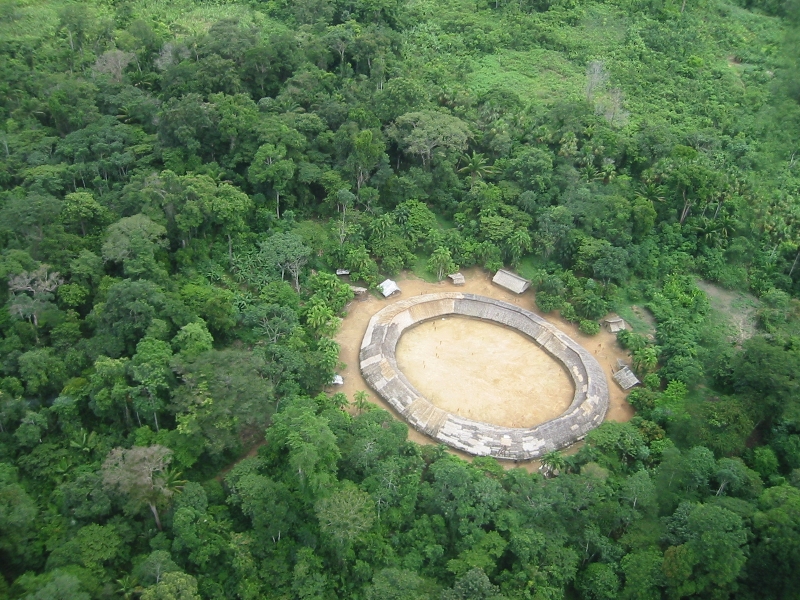
The Yanomami comprise a society of hunter-agriculturists of the tropical rainforest of Northern Amazonia, whose contact with non-indigenous society over the most part of their territory has been relatively recent. Their territory covers an area of approximately 192,000 km2, located on both sides of the border between Brazil and Venezuela, in the Orinoco-Amazon interfluvial region (affluents of the right shore of the Rio Branco and left shore of the Rio Negro). They make up a culturo-linguistic group composed of at least four adjacent subgroups who speak languages of the same family (Yanomae, Yanõmami, Sanima and Ninam). The total population of the Yanomami in Brazil and Venezuela is today estimated to be around 26,000 people.
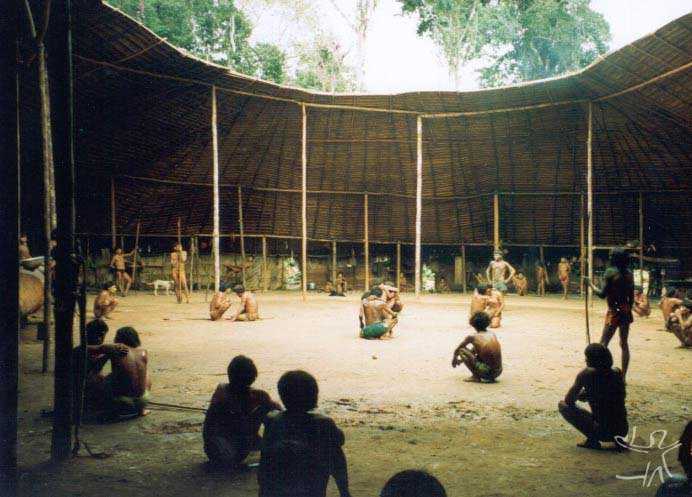
In Brazil, the Yanomami population numbers 12,795 people, split into 228 communities (National Health Foundation Census 1999). The Yanomami Indigenous Territory, which covers 9,664,975 ha (96,650 km2) of tropical forest is recognized for its importance in terms of protecting Amazonia's biodiversity and was ratified by Presidential decree on 25th May 1992.
The name yanomami
The ethnonym 'Yanomami' was produced by anthropologists on the basis of the word yanõmami which, in the expression yanõmami thëpë, signifies 'human beings.' This expression is opposed to the categories yaro (game animals) and yai (invisible or nameless beings), but also napë (enemy, stranger, 'white'). The Yanomami trace their origin to the copulation of the demiurge Omama with the daughter of the aquatic monster Tëpërësiki, owner of cultivated plants. Omama is attributed with the origin of the rules governing contemporary Yanomami society and culture, as well as the creation of the auxiliary spirits of shamans: the xapiripë (or hekurapë). The son of Omama was the first shaman. Omama's jealous and malevolent brother, Yoasi, is the origin of death and all the world's ills.
The whites: napëpë
A mythic narrative teaches that even peoples unknown to the Yanomami owe their existence to the powers of the demiurge Omama. It is told they were created from the bloody froth of a group of Yanomami ancestors, carried away by a flood after the breaking of a period of menstrual reclusion and devoured by alligators and otters. The 'tongue-tied' language of outsiders was transmitted to them by the buzzing of Remori, the mythic ancestor of the wasp commonly found on the beaches of the large rivers.
In order to arrive at this inclusion of whites in a common humanity, albeit as a result of a 'second-hand' creation, the ancestors of today's Yanomami had to pass through a long period of dangerous and tense encounters with these strange peoples, who they called napëpë ('strangers, enemies"). In fact, they first saw the whites as a group of ghosts coming from their dwelling place on the 'shores of the sky' with the scandalous proposal of returning to inhabit the world of the living (the return of the dead is a particularly important mythic and ritual theme for the Yanomami).
The ancient Yanomami
Because they have no genetic, anthropometric or linguistic affinity with their contemporary neighbors such as the Yekuana (of the Carib language family), geneticists and linguists who studied the Yanomami deduced that they were descendents of an indigenous group that had remained relatively isolated from a remote period of time. Once established as a linguistic grouping, the ancient Yanomami occupied the area comprised by the headwaters of the Orinoco and Parima rivers a thousand years ago, and there began their process of internal differentiation (700 years ago), eventually developing into their present-day languages.
According to Yanomami oral tradition and the earliest documents mentioning this indigenous group, the historical center of their habitat is located in the Parima mountain range, the watershed between the upper Orinoco and the right bank affluents of the Rio Branco. This is still the most densely populated area of their territory. The movement of dispersion of the Yanomami peoples from the Parima range in the direction of the surrounding lowlands probably began in the first half of the 19th century, after the colonial penetration into the regions of the upper Orinoco and the Rio Negro and Rio Branco in the second half of the 18th century. The contemporary configuration of Yanomami lands has its origins in this ancient migratory movement.
This geographical expansion of the Yanomami was possible, from the start of the 19th century until the start of the 20th century, due to dramatic demographic growth. A number of anthropologists believe that this population expansion was caused by economic transformations induced by the acquisition of new plants for cultivation and metal tools through exchange and warfare with neighboring indigenous groups (Carib, to the north and east; Arawak, to the south and west), who in turn maintained direct contact with the colonial frontier. The progressive emptying of the territory of these groups, decimated by contact with the regional white society throughout the 19th century, ended up also favoring the process of Yanomami expansion.
First Contacts
Until the end of the 19th century, the Yanomami only had contact with other neighboring indigenous groups.
In Brazil, the first direct encounters between Yanomami groups and representatives of the local extractive frontier (balata gum and piassava palm extractors, as well as hunters), soldiers of the Frontiers Commission, SPI workers and foreign travelers, took place in the decades between 1910 and 1940.
Between the 1940s and the middle of the 1960s, the opening of some SPI posts and, above all, various catholic and evangelical missions, established the first points of permanent contact within their territory. These posts comprised a network of poles of sedentarization, a regular source of manufactured objects and some healthcare assistance, but also very often a source of serious epidemical outbreaks (measles, influenza and whooping cough).
The age of development
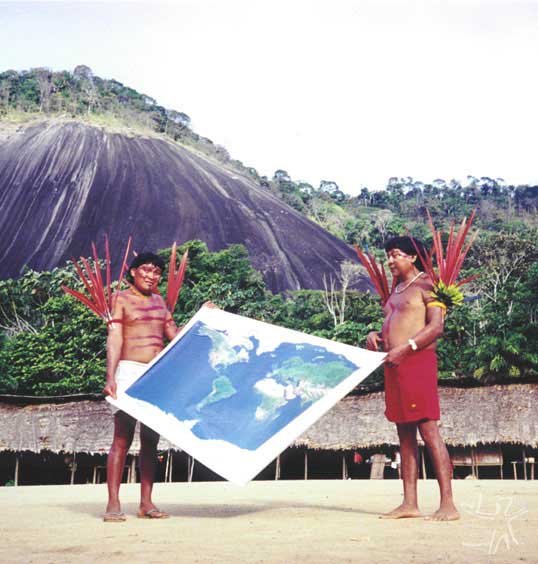
In the 1970s and 1980s, the State’s development projects began to submit the Yanomami to much more intense forms of contact with the expanding regional economic frontier, especially in the west of Roraima: roads, colonization projects, farmsteads, sawmills, masons and the first mineral prospectors. These contacts provoked an epidemiological shock of great magnitude, causing high demographic losses, a general deterioration in health conditions and, in some areas, serious damage to the social fabric.
The Northern Perimeter road
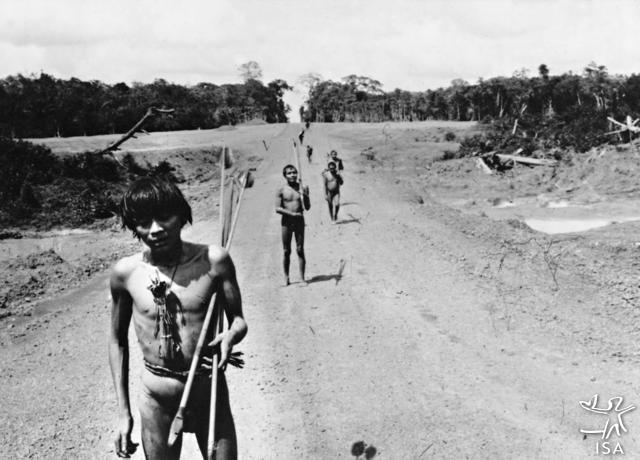
The two main forms of contact initially known to the Yanomami – first with the extraction frontier and later with the missionary frontier – coexisted until the start of the 1970s as a dominant conjunction of forces within their territory. However, the 1970s were marked (especially in Roraima) by the implementation of development projects under the aegis of the ‘National Integration Plan’ launched by the military governments during the period. This basically involved the opening of a section of the Northern Perimeter road (1973-76) and public colonization programs (1978-79) which invaded the southeast of Yanomami lands. During this same period, the RADAM Amazonian Resources Survey Project (1975) detected the existence of important mineral ore deposits in the region.
The publicity given to the mineralogical potential of the Yanomami territory unleashed an gradual invasion of propsectors, which became worse at the end of the 1980s and from 1987 onwards took the form of a full-scale gold rush.
The gold rush
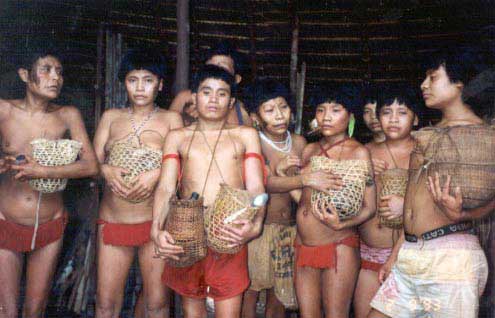
Over a hundred clandestine extraction tracks were opened up on the upper course of the main affluents of the Rio Branco between 1987 and 1990. The number of prospectors in the Yanomami area of Roraima was therefore estimated between 30,000 and 40,000, about five times the indigenous population residing there. Although the intensity of this gold rush had diminished considerably by the start of the 1990s, still today pockets of prospectors stubbornly continue on Yanomami lands, from where they spread violence and serious health and social problems.
Future threats?
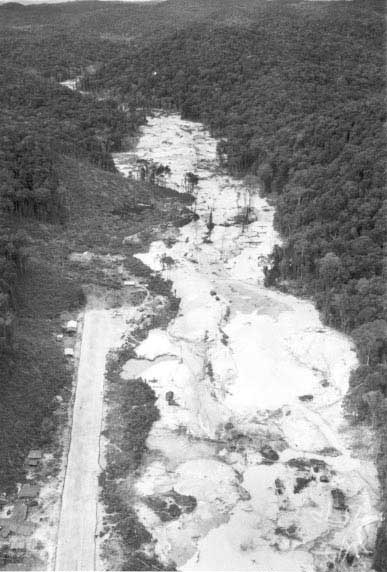
By the end of the 1980s, the expanding wave of mineral extraction had tended to supplant the previous forms of contact between the Yanomami and the surrounding non-indigenous society, even to the extent of eclipsing the frontier of development projects that had emerged in the 1970s. This does not mean, though, that other economic activities (commercial agriculture, logging and cattle ranching, industrial mining) that are still non-existent or in their early stages, may not comprise a new threat to Yanomami lands in the future, despite their demarcation and ratification.
Thus, in addition to the persisting interest of prospectors in the region, it should be noted that almost 60% of Yanomami territory is covered by mineral applications and title deeds registered in the National Department of Mineral Production by public and private mining companies, both national and multinational.
In addition, the colonization projects implemented in the 1970s and 1980s in the east and southeast of Yanomami lands created a wave of land occupation that is tending to expand inside the indigenous area (in the regions of Ajarani and Apiaú) due to the general migrationary flow in the direction of Roraima – a trend that may be exacerbated in the future as a result of the wiping out of the boundary markers by a huge forest fire that hit Roraima at the start of 1998.
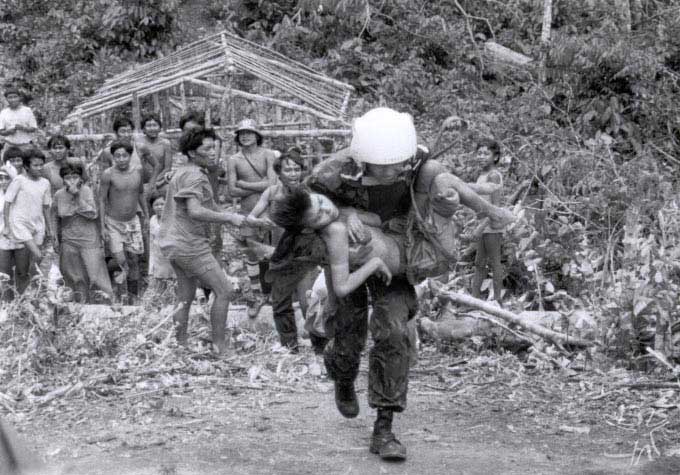
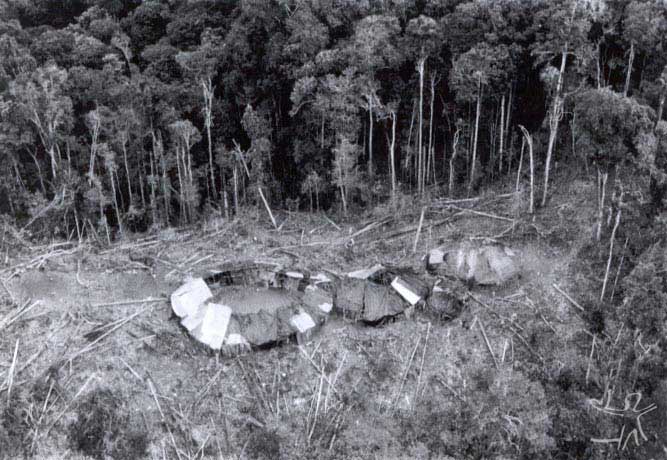
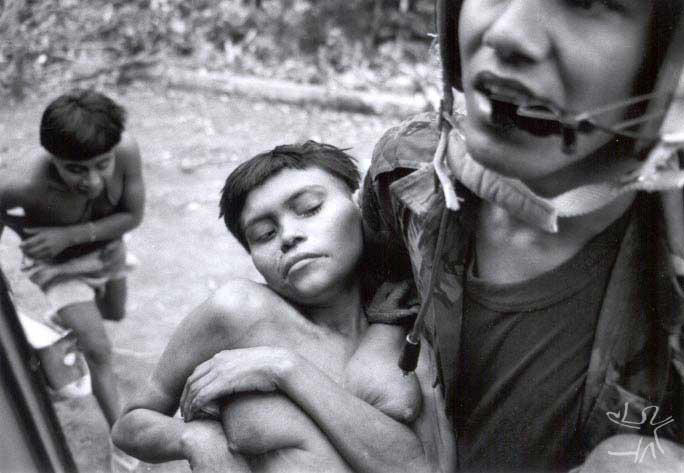
Finally, three military bases from the ‘Northern Trench Project’ have been installed in the Yanomami Territory since 1985 (The Special Border Platoons/ PEFs of Maturacá, Surucucus and Auaris, a fourth is planned in the Ericó region), leading to serious social problems (prostitution) among the local populations, which has already provoked protests from Yanomami leaders in Roraima.
The house, the village
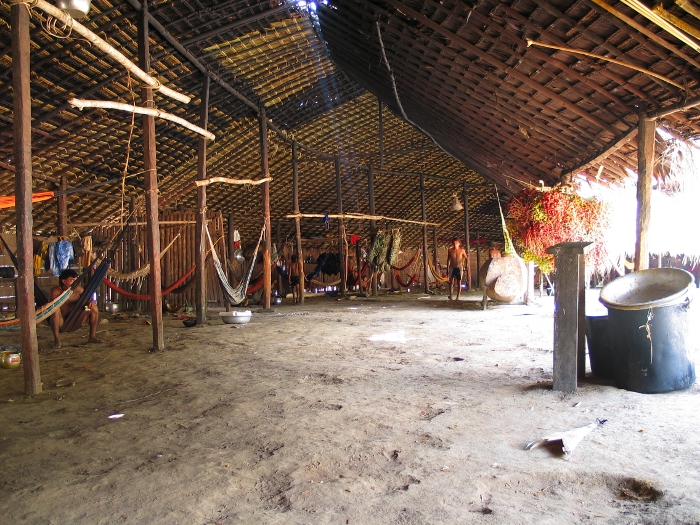
The Yanomami local groups are generally made up of a multifamily house in the shape of a cone or truncated cone called yano or xapono (eastern and western Yanomami), or by villages composed of rectangular-type houses (north and northeastern Yanomami).
Each collective house or village considers itself an autonomous economic and political entity (kami theri yamaki, ‘we co-residents’) and its members ideally prefer to marry inside this community of kin with a ‘cross’ cousin, that is the son or daughter of a maternal uncle or paternal aunt. This type of marriage is reproduced as far as possible between the families in a generation and from generation to generation, making the collective Yanomami house or village a dense and comfortable mesh of consanguine and affinal bonds.
The inter-village social space
However, despite this ideal autarchy, all local groups maintain a network of relations of matrimonial, ceremonial and economic exchange with various nearby groups, considered allies in opposition to other multicommunity groupings of the same nature. These groupings partially overlap to form a complex sociopolitical nexus, which links the totality of Yanomami collective houses and villages from one end of the indigenous territory to the other.
The social space beyond the collective house or village, considered as monads of close kinsfolk, is apprehended with suspicion as the dangerous universe of 'others' (yaiyo thëpë): visitors (hwamapë), who during the large funerary reahu intercommunity alliance ceremonies may cause sickness using sorcery to avenge insults, avarice or sexual jealousy; enemies (napë thëpë), who may kill, attacking the village as warriors (waipë) or sorcerers (okapë); unknown and distant people (tanomai thëpë), who may provoke lethal sicknesses by sending predatory shamanic spirits or by hunting the rixi animal double of a person (the rixi live in remote forest, far from their human double); finally, the 'whites' (napëpë), a paradoxical category of close strangers (potential enemies), feared for their epidemics (xawara) associated with smoke fumes produced by their 'machines' (mining machinery, airplane and helicopter motors) and the burning of their possessions (mercury and gold, paper, tarpaulins and rubbish).
Resource use
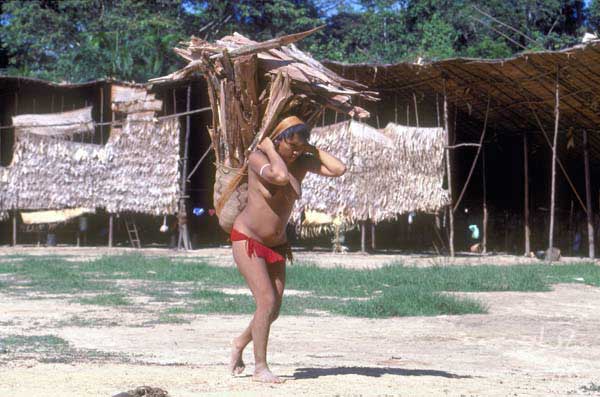
The space of the forest used by each Yanomami house-village can be described schematically as a series of concentric circles. These circles delimit areas with distinct modes and intensity of usage.
The first circle, within a five kilometer radius, circumscribes the area of immediate use by the community; small-scale female gathering, individual fishing or, in the summer, collective fishing with timbó poison, occasional brief hunting trips (at dawn or dusk) and agricultural activities. The second circle, within a five to ten kilometer radius, is the area of individual hunting (rama huu) and day-to-day family food gathering.

The third circle, within a ten to twenty kilometer radius, is the area used for the collective hunt expeditions (henimou) lasting one to two weeks that precede the funerary rituals (cremation of bones, burial or ingestion of ashes during the intercommunity reahu ceremonies), as well as the long multifamily hunting and gathering expeditions (three to six weeks) during the period when the new swiddens are ripening (waima huu). Also found in this 'third circle' are new and old swiddens: here, people make occasional encampments nearby in order to cultivate the former and harvest the latter, as well as hunt the abundant game in the vicinity.
The Yanomami used to spend between a third and almost half of the year camped in provisional shelters (naa nahipë) in different locations of this area of forest further away from their collective house or village.
This period of life in the forest tends to diminish when relations of regular contact with whites are established, as the Yanomami become dependent on them for access to medicines and merchandise.
Urihi, the forest-land
The Yanomami word urihi designates the forest and its floor. It also signifies territory: ipa urihi, 'my land,' may refer to the speaker's region of birth or the region currently inhabited; yanomae thëpë urihipë, 'the forest of human beings,' is the forest that Omama gave to the Yanomami to live in generation after generation; in our terms, it would be 'Yanomami land.' Urihi may also be used as a name for the world: urihi a pree, 'the great forest-land.' A cosmological geography.
A source of resources, for the Yanomami urihi, the forest-land, is not a simple inert setting submitted to the will of human beings. A living entity, it has an essential image (urihinari), breath (wixia), as well as an immaterial fertility principal (në rope).
The animals (yaropë) it shelters are seen to be avatars of mythic human/animal ancestors of the first humankind (yaroripë) who ended up assuming their animal condition due to their uncontrolled behavior, an inversion of present-day social rules. Lurking in the entangled depths of the urihi, in its hills and its rivers, are numerous malefic beings (në waripë), who injure or kill the Yanomami as though they were game, provoking disease and death. On top of the mountains live the images (utupë) of the animal-ancestors transformed into shamanic spirits, xapiripë.
The xapiripë were left behind by Omama to look after humans. The entire extent of urihi is covered by their mirrors where they play and dance endlessly. Hidden in the depths of the waters is the house of the monster Tëpërësiki, father-in-law of Omama, where the yawarioma spirits also live; their sisters seduce and madden young Yanomami hunters, thereby enabling them to pursue a shamanic career.
The xapiripë spirits
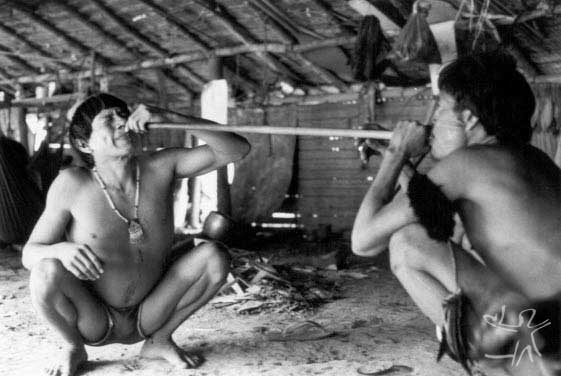
The initiation of shamans is painful and ecstatic. During initiation, which involves inhaling the hallucinogenic powder yãkõana (the resin or inner bark fragments of the Virola sp. tree, dried and pulverized) for many days under the supervision of older shamans, they learn to 'see/recognize' the xapiripë spirits and respond to their calls.
The xapiripë are seen in the form of humanoid miniatures decorated with colorful and brilliant ceremonial ornaments. Their presentation dance is compared to the noisy and exuberant arrival of richly decorated invited groups during an intercommunity reahu festival. Above all, these spirits are shamanic 'images' (utupë) of forest entities. There exist xapiripë of mammals, birds, fish, amphibians, reptiles, lizards, turtles, crustaceans and insects. There are also spirits of various trees, leaf spirits, vine spirits, wild honey spirits, water, stone and waterfall spirits... Many are also 'images' of cosmic entities (moon, sun, storm, thunder, lightning) and mythological personae. There also exist humble household xapiripë, such as the dog spirit, the fire spirit or the clay pot spirit. Finally, there are the spirits of 'whites' (the napënapëripë, activated through symbolic homeopathy to combat epidemics) and their domesticated animals (chicken, cattle, horse).
The shamans' work
Once initiated, the Yanomami shamans can summon the xapiripë to themselves in order for these to act as auxiliary spirits. This power of knowledge/vision and communication with the world of 'vital images/essences' (utupë) makes the shamans the pillars of Yanomami society. A shield against the malefic powers deriving from humans and non-humans that threaten the life of members of their communities, they are also tireless negotiators and warriors of the invisible, dedicated to taming the entities and forces that move the cosmological order.
They control the fury of the thunder and winds brought by storms, the regularity of the alternation between day and night, dry season and rainy season, the abundance of game and the fertility of swiddens; they keep up the arch of the sky to prevent its falling (the present earth is an ancient fallen sky), repel the forest's supernatural predators, counter-attack the raids made by aggressive spirits of enemy shamans, and primarily cure the sick, victims of human malevolence (sorcery, aggressive shamanism, attacks on animal doubles) or non-human malevolence (coming from the malefic në waripë beings).
Seeing the xapiripë spirits
To conduct their sessions, shamans inhale yãkõana powder, considered the food of spirits. Under its effect, they are said to 'die:' they enter a state of visionary trance during which they 'summon' to themselves and 'lower' various auxiliary spirits, with whom they then identify themselves, imitating the choreographies and songs of each one as they become active in the shamanic process (the shamans are designated xapiri thëpë, 'spirit people', while shamanry is called xapirimu, 'to act as a spirit'). Thus, when 'their eyes die,' shamans acquire a vision/power that, in contrast to the illusory perception of 'common people' (kua përa thëpë), gives them access to the essence of phenomena and to the time of their origins, and therefore the capacity to alter their course.
Sources of information
- ALBERT, Bruce. O corpo é uma bola de cristal para se ler o estado da sociedade e do mundo : entrevista. Tempo e Presença, Rio de Janeiro : Cedi, v. 13, n. 260, p. 25-6, nov./dez. 1991.
. Developpement et securité nationale : les Yanomami face au projet Calha Norte. Ethnies, Paris : Survival International, n.11/12, p.116-27, 1990.
. A fumaça do metal : história e representações do contato entre os Yanomami. Anuário Antropológico, Rio de Janeiro : Tempo Brasileiro, n. 89, p. 151-90, 1992.
. Gold miners and Yanomami indians in the Brazilian Amazon : the Hashimu massacre. In: JOHNSTON, B. (Ed.). Who pays the price? The sociocultural context of environmental crisis. Washington : Island Press, 1994. p. 47-55.
. Homologation des terres Yanomami. Ethnies, Paris : Survival International, v. 17, n. 29/30, p. 80-1, 2003.
. Indian lands, environmental policy, and military geopolitics in the development of the Brazilian Amazon : the case of the Yanomami. Development and Change, The Hague : Institute of Social Studies, v. 23, n. 1, p. 35-70, 1992.
. Indiens Yanomami et chercheurs d'or au Brésil: le massacre de Haximu. Journal de la Société des Américanistes, Paris : Société des Américanistes, v. 80, p. 250-7, 1994.
. Le massacre de Haximu. Survival: Les Nouvelles, Paris : Survival International, n. 12, p. 1, 4-5, nov. 1993.
. Le massacre de Haximu. Ethnies, Paris : Survival International, v. 17, n. 29/30, p. 16-25, 2003.
. O massacre dos Yanomami de Haximu. In: RICARDO, Carlos Alberto (Ed.). Povos Indígenas no Brasil : 1991/1995. São Paulo : Instituto Socioambiental, 1996. p. 203-7.
. L'Or cannibale et la chute du ciel : une critique chamanique de l'économie politique de la nature. L'Homme, Paris : École des Hautes Etudes en Sciences Soc., v. 33, n. 126/128, p. 349-78, abr./dez. 1993.
Publicado também na Série Antropologia da UnB n. 174, 1995.
. O ouro canibal e a queda do céu : uma crítica xamânica da economia política da natureza (Yanomami). In: ALBERT, Bruce; RAMOS, Alcida Rita (Orgs.). Pacificando o branco : cosmologias do contato no Norte-Amazônico. São Paulo : Unesp, 2002. p. 239-76.
. Pensée d'un sage, Davi, chamane Yanomami. In: MARTYNOW, A. Remiche; MADANES, G. Schneier (Eds.). Notre Amérique métisse : cinq cents ans après la conquête, les latino-américains parlent aux européens. Paris : La Découverte, 1992. p. 391-8.
. Pesquisa e ética : o caso Yanomami (contribuições brasileiras a controvérsia sobre o livro Trevas no El Dorado). Brasília : CCPY, 2002. 133 p. (Documentos Yanomami, 2)
(Ed.). Research and ethics : the Yanomami case (Brazilian contributions to the Darkness in El Dorado controversy). Brasília : CCPY, 2001. 121 p. (Documentos Yanomami, 2)
. Temps du sang, temps des cendres : representation de la maladie, system e rituel et espace politique chez les Yanomami du Sud-est. Paris : Univ. de Paris X, 1985. 833 p. (Tese de Doutorado)
. Terra, ecologia e saúde indígena : o caso Yanomami. In: BARBOSA, Reinaldo Imbrozio; FERREIRA, Efrem Jorge Gondim; CASTELLON, Eloy Guillermo (Eds.). Homem, ambiente e ecologia no estado de Roraima. Manaus : Inpa, 1997. p. 65-84.
. Terras indígenas, política ambiental e geopolítica militar no desenvolvimento da Amazônia : a propósito do caso Yanomami. In: LENÁ, Philippe; OLIVEIRA, Adélia Engrácia de (Orgs.). Amazônia : a fronteira agrícola 20 anos depois. Belém : MPEG, 1991. p. 37-58. (Coleção Eduardo Galvão)
. Urihi : terra, economia e saúde Yanomami. Brasília : UnB, 1991. 45 p. (Série Antropologia, 119)
(Org.). Yama ki kwërimamouwi thë ã oni : palavras escritas para nos curar. São Paulo : CCPY ; Brasília : MEC/Pnud, 1997. 92 p.
. Los Yanomamis en Brasil : nuevo gobierno, viejas amenazas. IWGIA: Asuntos Indígenas, Copenhagen : IWGIA, n. 2, p. 24-7, abr./jun. 1995.
; CASTRO, M. B.; PFEIFFER, W. C. Mercury levels in Yanomami indians hair from Roraima-Brazil. In: FARMER, J. G. (Ed.). Heavy metals in the environment. Edinburgh : CEP Consultants, 1991. p. 367-70.
; GOMEZ, Gale Goodwin. Saúde Yanomami : um manual etnolingüístico. Belém : MPEG, 1997. 304 p. (Coleção Eduardo Galvão)
; MILLIKEN, William. Plantas medicinais dos Yanomami : uma nova visão dentro da etnobotânica de Roraima. In: BARBOSA, Reinaldo Imbrozio; FERREIRA, Efrem Jorge Gondim; CASTELLON, Eloy Guillermo (Eds.). Homem, ambiente e ecologia no estado de Roraima. Manaus : Inpa, 1997. p. 85-110.
- ALES, Catherine. Etnologie ou discours-ecrans? Fragments dus discours amoreux amormami. In: MASQUELIER, B.; SIRAN, J. L., eds. Pour une anthropologie de l'interlocution : les rhetoriques du quotidien. Paris : L'Harmattan, 1993.
. Violencia y orden social : conflitos y guerra entre los Yanomami de Venezuela. Folklore Americano, México : Instituto Panamericano de Geografia e Historia, n. 55, p. 75-106, jan./jun. 1993.
- ALVES, Márcio Moreira. No país dos ianomamis. Rev. Geográfica Universal, Rio de Janeiro : s.ed., n. 220, p. 4-15, abr. 1993.
- ANDUJAR, Cláudia. Welch offizielle lösung gibt es für die Yanomami in Brasilien? Überlegungen beim betrachten ihrer zeichnungen. In: MÜNZEL, Mark (Org.). Die mythen sehen : bilder und zeichen vom Amazonas. Frankfurt : Museum fur Volkerfunde, 1988. p. 53-92.
- APARÍCIO, Teresa. La lucha de los yanomami por su territorio : entrevista con Claudia Andujar, coordinadora del CCPY (Comisión para la Creación del Parque Yanomami). IWGIA: Boletín, Copenhagen : IWGIA, n. 1, p. 24-30, jan./mar. 1992.
- ATHIAS, Renato; BRANDÃO, Maria do Carmo; PAULA, Nilton Cezar de (Orgs.). Saúde indígena em São Gabriel da Cachoeira : uma abordagem antropológica. Recife : Liber Gráfica e Ed., 2002. 232 p.
- BALÉE, William L. People of the fallow : a historical ecology of foraging in lowland South America. In: REDFORD, Kent H.; PADOCH, Christine J. (Eds.). Conservation of neotropical forests. Nova York : Columbia University Press, 1992. p. 35-57.
- BARANDIARÁN, Daniel de. Mundo espiritual y shamanismo Sanema. Antropológica, Caracas : Fundación La Salle de Ciencias Naturales, n.15, p.1-28, dez. 1965.
- BARAZAL, Neuza Romero. O confronto comunidade e sociedade perante os direitos humanos : o caso Yanomami. São Paulo : USP, 1997. 209 p. (Dissertação de Mestrado)
. Yanomami : um povo em luta pelos direitos humanos. São Paulo : Edusp, 2001. 207 p.
- BARBOSA, Ely. Yanomami, um grito nas selvas. s.l. : Maltese, 1996. 530 p.
- BARRETO, Carlos Alberto Lima Mena. A farsa Ianomami. Brasília : Bibl. do Exercito Ed., 1996. 216 p.
- BASTOS, Jorge Henrique (Org.). A criação do mundo segundo os índios Ianomami. Lisboa : Hiena, 1994. 111 p. (Cão Vagabundo, 39)
- BEAUCAGE, P. Donner et prendre : Garifunas et Yanomamis. Anthropologie et Sociétés, s.l. : s.ed., v. 19, n. 1/2, p. 95-117, 1995.
- BERWICK, Dennison. Savages : the life and killing of the Yanomami. Toronto : MacFarlane Walter & Ross, 1992. 254 p.
- BEZERRA, A. J. C.; BEZERRA, A. S. A.; LOPES, A.C. et al. Anatomical terms of Yanomami indian translated into Portuguese and English. Rev. da Assoc. Med. Brasil., São Paulo : Associação Medica Brasileira, v. 40, n. 3, p. 179-85, jul./set. 1994.
- BIOCCA, Ettore. Yanoama : dal racconto di una donna rapita dagli indii. Bari : De Donato, 1965. 394 p.
- BORGES, Maria Inês Smiljanic. O corpo cósmico : o xamanismo entre os Yanomae do Alto Toototobi. Brasília : UnB, 1999. 218 p. (Tese de Doutorado)
. Das amazonas aos Yanomami : fragmentos de um discurso exotizante. Brasília : UnB, 1995. 84 p. (Dissertação de Mestrado)
- BRASIL : el gobierno dilata la expulsión de buscadores de oro. IWGIA: Asuntos Indígenas, Copenhagen : IWGIA, n. 4, p. 40-1, out./dez. 1996.
- BRASIL : portaria n. 580 que demarca o território da população indígena Yanomami. Anuário Indigenista, México : Instituto Indigenista Interamericano, v. 30, p. 461-71, dez. 1992.
- BRITO, Maria Edna de. Etno alfabetização Yanomama : da comunicação oral à escrita. São Paulo : M.E. Brito, 1996. 120 p.
- CARNEIRO, Robert L. Forest clearance among the Yanomamo : observations and implications. Antropológica, Caracas : Fundación La Salle de Ciencias Naturales, n. 52, p. 39-76, 1979.
- CARRERA, Javier. Apuntes para el análisis de la gestión del territorio Yanomami. IWGIA: Documento, Copenhague : IWGIA, n. 23, p. 160-74, 1998.
- CARVALHO, Jairo Jesus Mancilha. Estudo da pressão arterial de índios Yanomami. Rio de Janeiro : UFRJ, 1986. 89 p. (Tese de Doutorado)
- CASTRO, Lídia Montanha (Org.). Nape pe esikora e the a oni. São Paulo : CCPY, 1999. 11 p.
; ALBERT, Bruce (Orgs.). The a onini pihi moyamimaiwi siki. São Paulo : CCPY, 1998. 130 p.
- LA CATASTROPHE des Yanomamis : un aperçu, de 1979 à aujourd'hui. Recherces Am. au Québec, Montreal : Soc. de Recherches Amer. au Québec, v. 22, n. 4, p. 70-4, 1992/1993.
- CCPY. Haximu : foi genocídio!. Brasília : CCPY, 2001. 74 p. (Documentos Yanomami, 1)
. Nape urihihami proheso yanomae the pe kwamamowi siki. São Paulo : CCPY, 1999. 18 p.
. Omamani urihi a hapa thaprariwi e the a oni. São Paulo : CCPY, 1999. 13 p.
. Report on health work in the Yanomami Area, medical care and dental health : Area 15 (Demini Project) and other areas - January 1990 to May 1991. São Paulo : CCPY, 1991. 62 p.
. Yama ki estutamouwi the a oni. São Paulo : CCPY, 2000. 22 p.
- CCPY. Programa de Educação. Nomeru pe kokamaiwi siki. São Paulo : CCPY, 1999. 60 p.
. Nomeru pe ukamaiwi siki. São Paulo : CCPY, 1999. 48 p.
. Nomeruni pihi moyamimaiwi siki. São Paulo : CCPY, 1998. 85 p.
- CCPY; SECOYA. Pesquisa dos professores Yanomami sobre os povos do Xingu. Boa Vista : CCPY ; Manaus : Secoya, 2002. 42 p.
- CHAGNON, Napoleon A. The culture-ecology of shifting (pioneering) cultivation among the Yanomamo indians. In: GROSS, Daniel R. (Ed.). Peoples and cultures of native South America : an anthropological reader. New York : The American Museum of Natural Story, 1973. p. 126-44.
. L'ethnologie du déshonneur : brief response to Lizot. American Ethnologist, Washington : American Anthropological Association, v. 22, n. 1, p. 187-9, 1995.
. Yanomamo : the last days of Eden. San Diego : Harcourt Brace Jovanovich, 1992. 309 p.
. Yanomamo warfare, social organization and marriage alliances. Ann Arbor : Univ. of Michigan, 1966. 233 p. (Tese de Doutorado - University Microfilms International 67-08226)
- CHAVES, Cláudio do Carmo. Oncocercose ocular na Amazônia brasileira. Ribeirão Preto : USP/FMRP, 1994. 110 p. (Tese de Doutorado)
- CHIAPPINO, Jean; ALES, Catherine (Eds.). Del microscopio a la maraca. Caracas : Ex Libris, 1997. 402 p.
- CLAY, Jason (ed.). The impact of contact : two Yanomama case studies. Cambridge : Cultural Survival and Bennington College, 1983.
- COCCO, Luis. Iyëwei-Teri : quince años entre los Yanomamos. Caracas : Escuela Técnica Popular Don Bosco, 1972.
- COELHO, Giovanini Evelim et al. identificação de áreas de estratificação epidemiológica no foco de oncocercose na região Yanomami, Roraima, Brasil. Cadernos de Saúde Pública, Rio de Janeiro : Fiocruz/ENSP, v. 14, n. 3, p. 607-11, jul./set. 1998.
- COLCHESTER, Marcus. The cosmovision of the Venezuelan Sanema. Antropológica, Caracas : Fundación La Salle de Ciencias Naturales, n. 58, p.97-122, 1982.
. Ecological modelling and indigenous systems of resource use : some examples from the Amazon of South Venezuela. Antropológica, Caracas : Fundación La Salle de Ciencias Naturales, n. 55, p. 51-72, 1981.
- CREWS, Douglas E. et al. Population genetics of apolipoprotein A4, E, and H polymorphisms in Yanomami indians of Northwestern Brazil : associations with lipids, lipoproteins, and carbohydrate metabolism. Human Biology, Detroit : Human Biology Council, v. 65, n. 2, p. 211-24, 1993.
- CUNHA, Manuela Carneiro da. O drama dos Yanomami: entrevista. Ciência Hoje, Rio de Janeiro : SBPC, v. 12, n. esp., p. 48-53, dez. 1991.
- DENIS, Richer. Pays perdu : avec les Maia, parias de l'Amazonie. Paris : Phebus, 1993. 159 p. (D'Ailleurs)
- DINIZ, Edson Soares. Aspectos das relações sociais entre os Yanomamo do Rio Catrimâni. Boletim do MPEG: Série Antropologia, Belém : MPEG, n. 39, 22 p., 1969.
- DONNER, Florinda. Shabono : uma viagem ao universo místico dos índios Yanomami. Rio de Janeiro : Record, 1994.
- DUARTE, Rogério; PELLEGRINO, Silvia Pizzolante. Agressão, aliança e reflexividade : a guerra yanomami por meio de uma experiência de comunicação. Sexta Feira: Antropologia, Artes e Humanidades, São Paulo : Pletora, n. 7, p. A57-A66, 2003.
- EARLY, John D.; PETERS, John F. The population dynamics of the Mucajai Yanomama. San Diego : Academic Press, 1990. 152 p.
. The Xilixana Yanomami of the Amazon : history, social structure, and population dynamics. Gainesville : Univ. Press of Florida, 2000. 335 p.
- EMIRI, Loretta. Amazzonia portatile. San Cesario di Lecce : Manni Editori, 2003. 120 p.
. Cartilha Yãnomame. Monte Urano : Missão Catrimâni, 1982. 111 p.
. Dicionário yãnomamè-português. São Paulo : CPI-RR, 1987. 95 p.
. Gramática pedagógica da língua yãnomamè. Boa Vista : Missão Catrimâni, 1981. 76 p.
. Leituras yãnomamè. Monte Urano : Missão Catrimâni, 1982. 72 p.
. Mulher entre três culturas : ítalo-vrasileira “educada” pelos Yanomami. São Paulo : Edicon, 1992. 64 p.
. Yanomami para brasileiro ver. Fermo : CPI-RR, 1994. 56 p.
- ESCUELA INTERCULTURAL BILÍNGÜE YANOMAMI. Yoahiwe. São Gabriel da Cachoeira : Diocese de São Gabriel da Cachoeira ; Manaus : Isma, 1993. 230 p. (Texto de Leitura, 1)
- ESPOSITO, Rubens. Yanomami : um povo ameaçado de extinção. Rio de Janeiro : Dunya, 1998. 114 p.
- EUSEBI, Luigi. A barriga morreu! : o genocídio dos Yanomami. São Paulo : Loyola, 1991. 149 p.
- FERGUSON, R. B. Yanomami warfare : a political history. Santa Fe : School of Amer. Res. Press, 1995. 464 p.
- FINKERS, Juan. Los Yanomami y su sistema alimenticio (Yanomami nii pe). s.l. : Vicariato Apostolico de Puerto Ayacucho, 1986. 262 p. (Monografia, 2)
- FONDATION CARTIER POUR L'ART CONTEMPORAIN. Yanomami : l'esprit de la foret - Catalogue Exposition. Paris : Fondation Cartier, 2003. 206 p.
- FREDLUNG, Eric Victor. Shitari yanomamo incestuous marriage : a study of the use of structural, lineal and biological criteria when classifying marriages. Pennsylvania : Pennsylvania State University, 1982. 180 p. (Ph. D. Dissertation - University Microfilms International 82-13302)
- FUENTES, Emilio. Los Yanomami y las plantas silvestres. Antropológica, Caracas : Fundación La Salle de Ciencias Naturales, n. 54, p.3-138, 1980.
- FUNDAÇÃO NACIONAL DE SAÚDE. Projeto saúde Yanomami. Brasília : Funasa, 1991. 71 p.
- GARCIA, Maria Isabel Eguilor. Yopo, shamanes y hekura : aspectos fenomenologicos del mundo sagrado Yanomami. Caracas : Libreria Editorial Salesiana, 1984. 244 p.
- GOOD, Kenneth; CHAGNOFF, David. Dentro do coração : uma viagem inesquecível pela cultura Yanomami e pelos caminhos do amor. Sao Paulo : Best Seller, 1991.
. Into the heart : one man's pursuit of love and knowledge among the Yanomama. New York : Simões & Schuster, 1991. 349 p.
- HAMES, Raymond B. The settlement pattern of a Yanomamo population bloc : a behavioral ecological interpretation. In: HAMES, Raymond B.; VICKERS, William T. (Eds.). Adaptive responsees of native amazonians. New York : Academic Press, 1983. p. 393-428.
- HANBURY-TENISON, Robin. Les aborigènes de l'Amazonie : les Yanomami. Amsterdan : Time-Life, 1982. 168 p.
- ISTRIA, Jacques; GAZIN, Pierre. O estado nutricional de crianças Yanomami do médio Rio Negro, Amazônia. Rev. da SBTM, s.l. : SBTM, v. 35, n. 3, p. 233-6, mai./jun. 2002.
- JANK, Margaret. Mission : Venezuela - reaching a new tribe. Sanford : New Tribes Mission, 1977.
- KERJEAN, Alain. L'adieu aux Yanomami. Paris : A. Michel, 1991. 248 p. (Aventures Albin Michel)
- LAUDATO, Luís. Yanomami Pey Keyo. Brasília : Univ. Católica Brasília, 1998. 326 p.
- LIZOT, Jacques. La agricultura Yanomami. Antropológica, Caracas : Fundación La Salle de Ciencias Naturales, n. 53, p. 3-93, 1980.
. O círculo dos fogos : feitos e ditos dos índios Yanomami. São Paulo : Martins Forntes, 1988.
. Contribution à l'étude de la technologie Yanomami. Antropológica, Caracas : Fundación La Salle de Ciencias Naturales, n. 38, p. 15-33, 1974.
. Diccionario Yanomami-Español. Caracas : Universidad Central de Venezuela, división de Publicaciones, 1975.
. On warfare : an answer to N. A. Chagnon. American Ethnologist, Arlington : American Anthropological Association, v. 21, n. 4, p. 845-62, 1994.
. Poison Yanomami de chasse, de guerre et de pêche. Antropológica, Caracas : Fundación La Salle de Ciencias Naturales, n. 31, p. 3-20, 1972.
. El rio de los Periquitos : breve relato de un viaje entre los Yanomami del Alto Siapa. Antropológica, Caracas : Fundación La Salle de Ciencias Naturales, n. 37, p. 3-23, 1974.
. Tales of the Yanomami : daily life in the Venezuelan forest. Cambridge : Cambridge Univ. Press ; Paris : Maison des Sciences de l'Homme, 1985. 218 p.
. Los Yanomami. In: COPPENS, Walter (Ed.). Los aborigenes de Venezuela. v.3. Caracas : Fundación la Salle de Ciencias Naturales ; Monte Avila Eds, 1988. p. 479-583.
. Los Yanomami ante su destino. Antropológica, Caracas : Fundación La Salle, n. 90, p. 3-18, 1998/1999.
; COCCO, Luis; FINKERS, Juan. Mitologia Yanomami. Quito : Abya-Yala ; Roma : MLAL, 1991. 260 p. (Colección 500 Años, 39)
- LOBO, Maria Stella de Castro. O caso Yanomami do Brasil : uma proposta estratégica de vigilância epidemiológica. Rio de Janeiro : Fiocruz, 1996. 128 p. (Dissertação de Mestrado)
; BLOCH, Katia et al. Pressão arterial, glicemia capilar e medidas antropometricas em uma população Yanomami. Cadernos de Saúde Pública, Rio de Janeiro : Fiocruz, v. 9, n. 4, p. 428-38, out./dez. 1993.
- MacMILLAN, Gordon. At the end of the rainbow? : gold, land, and people in the Brazilian Amazon. New York : Columbia University Press, 1995. 216 p. (Perspectives in Biological Diversity Series)
- MAGALHÃES, Edgard Dias. O Estado e a saúde indígena : a experiência do Distrito Sanitário Yanomami. Brasília : UnB, 2001. 203 p. (Dissertação de Mestrado)
- MARMORI, Margareth. A história do conflito. Ciência Hoje, Rio de Janeiro : SBPC, v. 12, n. esp., p. 54-6, dez. 1991.
- MELANCON, Thomas F. Marriage and reproduction among the Yanomamo indians of Venezuela. Pennsylvania : Pennsylvania State University, 1982. (Tese de Doutorado - University Microfilms International 82-13331)
- MIGLIAZZA, Ernesto. Linguistic prehistory and the refuge model in Amazonia. In: PRANCE, G. T. (Org.). Biological diversification in the tropic. New York : Columbia University Press, 1982. p. 497-519.
. Notas sobre a organização social dos Xiriana do rio Uraricaá. Boletim do MPEG: Série Antropologia, Belém : MPEG, n. 22, 1964.
. Yanomama grammar and intelligibility. s.l. : University of Indiana, 1972. (Tese de Doutorado)
- MILLIKEN, William; ALBERT, Bruce. The construction of a new Yanomami round-house. Journal of Ethnobiology, s.l. : s.ed., v. 17, n. 2, p. 215-33, 1997.
. The use of medicinal plants by the Yanomami indians of Brazil. Economic Botany, Bronx : The New York Botanical Garden, v. 50, n. 1, p. 10-25, 1996.
. The use of medicinal plants by the Yanomami indians of Brazil, part II. Economic Botany, Bronx : New York Botanical Garden, v. 51, n. 3, p. 264-78, 1997.
- MILLIKEN, William; ALBERT, Bruce; GOMEZ, Gale Goodwin. Yanomami : a forest people. Kew : Royal Botanic Gardens, 1999. 169 p.
- MONTOYA, Ruben Antonio. El pueblo Yanomami : ocupación capitalista de la tierra y genocídio. In: CASTRO, Edna M. Ramos de; MARIN, Rosa E. Acevedo (Orgs.). Amazônias em tempo de transição. Belém : UFPA-Naea, 1989. p. 103-50. (Cooperação Amazônica, 4)
- MORAES, Mário A. P. Oncocercose entre os índios Yanomami. Cadernos de Saúde Pública, Rio de Janeiro : Fiocruz, v. 7, n. 4, p. 503-14, out./dez. 1991.
- MOREIRA, Memélia. A estratégia do genocídio Yanomami. In: RICARDO, Carlos Alberto (Ed.). Povos Indígenas no Brasil : 1987/88/89/90. São Paulo : Cedi, 1991. p. 162-4. (Aconteceu Especial, 18)
- MUSKEN, R. Les Yanomami ne passent plus sur CNN. Libertés!, s.l. : s.ed., n. 324, p. 3-4, 1996.
- NICHOLAS, George P. The yanomami in the classroom. Cultural Survival Quarterly, Cambridge : Cultural Survival, v. 16, n. 2, p. 28-30, maio 1992.
- OLIVEIRA, Cláudio Esteves de; FRANCISCO, Deise Alves. Projeto de saúde Yanomami no Demini, Tootobi e Balawaú. In: RICARDO, Carlos Alberto (Ed.). Povos Indígenas no Brasil : 1991/1995. São Paulo : Instituto Socioambiental, 1996. p. 213-5.
. Quarto relatório de atividades de saúde na Área Yanomami : Demini - Toototobi - Balawau - dezembro de 1993 a setembro de 1994. São Paulo : CCPY, 1994. 20 p.
. Quinto relatório de atividades de saúde na Área Yanomami : Toototobi - Balawau - Demini - 1994. São Paulo : CCPY, 1995. 24 p.
. Sétimo relatório de atividades de saúde na área Yanomami - Toototobi, Balalaw, Demini : 1996. São Paulo : CCPY, 1997. 32 p.
. Sexto relatório de atividades de saúde na área Yanomami - Toototobi, Balawau, Demini - 1995 : considerações históricas e socio-ambientais de importância epidemiológica. São Paulo : CCPY, 1996. 60 p.
. Terceiro relatório de atividades de saúde na Área Yanomami : Demini - Toototobi - Balawau - abril a novembro de 1993. São Paulo : CCPY, 1994. 76 p.
- OLIVETTI DO BRASIL S.A (Ed.). Mitopoemas Yanomami. São Paulo : Olivetti, 1978.
- PASSARINHO, Jarbas. Terras dos Yanomami. Carta, Brasília : Gab. Sen. Darcy Ribeiro, n. 9, p. 241-54, 1993.
- PAULA, Jayter Silva de. Tracoma em índios Yanomami do Médio Rio Negro. Ribeirão Preto : FMRB, 2002. 103 p. (Tese de Doutorado)
- PELLEGRINI, Marcos A. Do alto da cedrorana. In: RICARDO, Carlos Alberto (Ed.). Povos Indígenas no Brasil : 1991/1995. São Paulo : Instituto Socioambiental, 1996. p. 245-6.
. Falar e comer : um estudo sobre os novos contextos de adoecer e buscar tratamento entre os Yanomame do Alto Parima. Florianópolis : UFSC, 1998. 160 p. (Dissertação de Mestrado)
. O lugar dos Yanomami doentes no sistema único de saúde. In: RICARDO, Carlos Alberto (Ed.). Povos Indígenas no Brasil : 1991/1995. São Paulo : Instituto Socioambiental, 1996. p. 211-2.
. Wadubari. Habana : Casa de las Americas, 1991. 132 p.
. Wadubari. São Paulo : Marco Zero, 1993. 132 p.
- PETERS, John F. Life among the Yanomami. Ontário : Broadview Press, 1998.
- PITHAN, Oneron A.; CONFALONIERI, Ulisses E. C.; MORGADO, Anastácio F. A situação de saúde dos índios Yanomami : diagnóstico a partir da casa do índio de Boa Vista, Roraima, 1987-1989. Cadernos de Saúde Pública, Rio de Janeiro : Fiocruz, v. 7, n. 4, p. 563-80, out./dez. 1991.
- PY-DANIEL, Víctor. Oncocercose, uma endemia focal no hemisfério norte da Amazônia. In: BARBOSA, Reinaldo Imbrozio; FERREIRA, Efrem Jorge Gondim; CASTELLON, Eloy Guillermo (Eds.). Homem, ambiente e ecologia no estado de Roraima. Manaus : Inpa, 1997. p. 111-56.
- RABBEN, Linda. Demarcation - and then what? Cultural Survival Quarterly, Cambridge : Cultural Survival, v. 17, n. 2, p. 12-4, ago. 1993.
. Un natural selection : the Yanomami, the Kayapo and the Onslaught of civilisation. Londres : Pluto Press, 1998. 183 p.
- RAMIREZ, Henri. Hapa Të Pë Rë Kuonowei : mitologia Yanomami. Manaus : Isma, 1993. 238 p. (Texto de Leitura, 2)
. Iniciação a língua Yanomama : dialetos do médio rio Catrimani e de Xitei, curso de língua Yanomama. Boa Vista : Diocese de Roraima, 1994. 114 p.
. Iniciação a língua yanomami. Manaus : Belvedere, 1992. 187 p.
. Le parler Yanomami des Xamatauteri. Provence : Univ. de Provence, 1994. 430 p. (Tese de Doutorado)
- RAMOS, Alcida Rita. Auaris revisitado. Brasília : UnB, 1991. 72 p. (Série Antropologia, 117)
. Memórias Sanumá : espaço e tempo em uma sociedade Yanomami. São Paulo : Marco Zero ; Brasília : UnB, 1990. 344 p.
. Old ethics die hard : the Yanomami and scientific writing. Brasília : UnB, 2001. 10 p. (Serie Antropologia, 302)
. O papel político das epidemias : o caso Yanomami. In: BARTOLOME, Miguel A. (Coord.). Ya no hay lugar para cazadores : processo de extincción y transfiguración étnica en America Latina. Quito : Abya-Ayala, 1995. p. 55-91. (Biblioteca Abya-Yala, 23)
Publicado inicialmente na Série Antropologia, n. 153, da Universidade de Brasília, 1993.
. Por falar em paraíso terrestre. Brasília : UnB, 1995. 10 p. (Série Antropologia, 191)
. A profecia de um boato. Brasília : UnB, 1995. 22 p. (Série Antropologia, 188)
. Rumor : the ideology of na inter-tribal situation. Antropológica, Caracas : Fundación La Salle de Ciencias Naturales, n. 51, p. 3-25, 1979.
. Sanumá, Maiongong. In: RAMOS, Alcida Rita. Hierarquia e simbiose : relações intertribais no Brasil. São Paulo : Hucitec, 1980. p. 19-130.
. Sanuma memories : Yanomami ethnography in times of crises. Madison : Univ. of Wisconsin Press, 1995. 366 p.
. The social system of the Sanuma of northern Brazil. Wisconsin : University of Wisconsin, 1972. 209 p. (Tese de Doutorado - University Microfilms International 72-23759)
. Tierra y supervivencia cultural yanomami. IWGIA: Boletín, Copenhagen : IWGIA, n. 1, p. 13-20, jul./ago. 1991.
. Yanomami : a homeland undermined. IWGIA: Newsletter, Copenhagen : IWGIA, s.n., p. 13-20, 1991.
. Yanomami and gender toward a Sanuma theory of knowledge. Brasília : UnB, 1996. 19 p. (Série Antropologia, 202)
- RE, Giorgio; RE, Fabrizio. Gli ultimi Yanomami. Torino : Point Couleur, 1984. 338 p.
. Um mergulho na pré-historia : Os últimos Yanomami? A aventura de dois méddicos em visita aos irmãos Laudato, entre os Yanomami. Manaus : Calderaro, 1988. 256 p.
- RESTREPO G., Amparo. La mujer Yanomami. Ethnia, Nedellin : Instituto Misionero de Antropologia, n. 72, p. 4-60, 1993.
- RICARDO, Carlos Alberto. O massacre de Hwaximeutheri : questões limite na fronteira. Tempo e Presença, Rio de Janeiro : Cedi, v. 15, n. 270, p. 27-30, jul./ago. 1993.
- RICCIARDI, Mirella. Vanishing Amazon. Londres : Weidenfeld and Nicolson, 1991. 240 p.
- RIFKIN, Jeffery. Ethnography and ethnocide : a case study of the Yanomami. Dialectical Anthropology, Amsterdã : Elsevier Science Publishers, v. 19, n. 23, p. 295-327, 1994.
- RITCHIE, M. Spirit of the rain-forest : a yanomamo shaman's story. Chicago : Island Lake Press, 1996. 271 p.
- RIVIÈRE, Peter. AAE na Amazônia. Rev. de Antropologia, São Paulo : USP, v. 38, n. 1, p. 191-203, 1995.
- ROCHA, Jan. Murder in the rainforest : the Yanomami, the gold miners and the Amazon. Londres : Survival International, 1999. 96 p.
- ROYERO, Ramiro. Algunos aspectos de la etnoictiologia y la historia natural de los Yanomami del alto rio Siapa y rio mavaca, Estado Amazonas, Venezuela. Antropológica, Caracas : Fundación La Salle, n. 84, p. 73-96, 1994/1996.
- SAFFIRIO, Giovanni. Ideal and actual kinship terminology among the Yanomama indians of the Catrimani river basin (Brazil). Pittsburgh : Univ. of Pittsburgh, 1985. 244 p. (Tese de Doutorado)
. Some social and economic changes among the Yanomama of northern Brazil (Roraima) : a comparison of "forest" and "highway" villages. Pittsburgh : Univer. of Pittsburgh, 1980. 119 p. (Dissertação de Mestrado)
- SALAMONE, Frank A. (Ed.). Who speaks for the Yanomamo? s.l. : s.ed., 1996. (Studies in Third World Societies, 57)
. The Yanomami and their interpreters : fierce peoples or fierce academics? Laham : Univer. Press of America, 1997. 140 p.
- SALDANHA, Paula; WERNECK, Roberto. Expedições, terras e povos do Brasil : Yanomamis e outros povos indígenas da Amazônia. Rio de Janeiro : Edições del Prado, 1999. 95 p.
- SÁNCHEZ, Pedro; JAFFÉ, Klaus. Los Yanomami y el cacao : dos realidades. Interciencia, Caracas : Interciencia Association, v. 17, n. 2, p. 71-2, mar./abr. 1992.
- SHAPIRO, Judith Era. Sex roles and social structure among the Yanomama indians of Northem Brazil. New York : Columbia University, 1972. (Tese de Doutorado - University Microfilms International 72-28096)
- SILVA, Orlando Sampaio. Notas sobre algunos pueblos indígenas de la frontera amazónica de Brasil en otros paises de sudamerica. In: JORNA, P.; MALAVER, L.; OOSTRA, M. (Coords.). Etnohistoria del Amazonas. Quito : Abya-Yala ; Roma : MLAL, 1991. p. 117-32. (Colección 500 Años, 36)
- SIMIONI, Tenn. Piloto Ianomami. Belém : Cejup, 1994. 320 p.
- SOLARTE, Benhur Ceron. El manejo indígena de la selva pluvial tropical : orientaciones para un desarrollo sostenido. Quito : Abya-Yala ; Roma : MLAL, 1991. 256 p. (Colección 500 Años, 43)
- STANFORD, Zent; WAGNER, Erika. El mito de los Yanomami y el cacao. Interciencia, Caracas : Interciencia, v. 17, n. 2, p. 70-1, mar./abr. 1992.
- TAYLOR, Kenneth Iain. Sanumá fauna : prohibitions and classifications. Caracas : Fundación La Salle de Ciencias Naturales, 1974. (Monografia, 18)
. Sanumá food prohibitions and Para-totemic classification. Antropológica, Caracas : Fundación La Salle de Ciencias Naturales, n. 51, p. 63-92, 1979.
. Sanuma (Yanoama) food prohibitions the multiple classification of society and fauna. Wisconsin : University of Wisconsin, 1972. 230 p. (Tese de Doutorado - University Microfilm International 72-23766)
- THIELE, Richard A. Interrogatives in Yanomam. Brasília : SIL, 1993. 51 p. (Arquivo Lingüístico)
- TIERNEY, Patrick. Darkness in Eldorado : how scientists and journalists devastated the Amazon. New York : W.W. Norton & Company, 2000. 446 p.
. Last tribes of El Dorado : the gold wars in the Amazon rain forest. New York : Viking, 1995.
- TRUPP, Fritz. The Yanomami. In: --------. The last indians : South America's cultural heritage. Wörgl (Áustria) : Perlinger, 1981. p. 13-44.
- TURNER, Terence; YANOMAMI, Davi Kopenawa. "I fight because I am alive" : an interview with Davi Kopenawa Yanomami. Cultural Survival Quarterly, Cambridge : Cultural Survival, v. 15, n. 3, p. 59-64, ago. 1991.
- URIHI-SAÚDE YANOMAMI. Hura taatima a the a oni : manual do microscopista Yanomami. Boa Vista : Urihi, 1999. 39 p.
. Manual terapêutico : um guia dos principais esquemas de tratamento para uso pelos profissionais de saúde da área Yanomami. Boa Vista : Urihi, 2000. 67 p.
- VALERO, Helena. Yo soy Napëyoma : relato de una mujer raptada por los indígenas Yanomami. Caracas : Fundación La Salle, 1984. 550 p.
- VARGA, Istvan Van Deursen. Histórias que os médicos deviam aprender a contar. Tempo e Presença, Rio de Janeiro : Cedi, v. 13, n. 260, p. 23-5, nov./dez. 1991.
- VERDUM, Ricardo. Os Yawaripe : contribuição a história do povoamento Yanomami. Brasília : UnB, 1996. 184 p. (Dissertação de Mestrado)
- VILA, Marciano Figueira da. Estudo das alterações oculares na região oncocercitica Yanomami. São Paulo : Unifesp/EPM, 1992. (Tese de Doutorado)
- VUUREN, Chris van. To fight over women and to lose your land : violence in anthropological writing and the Yanomamo of Amazonia. Unisa Latin American Report, Pretoria : Univ. of South Africa, v. 10, n. 2, p. 10-20, 1994.
- WEIDMANN, Karl; BOADAS, Antônio; LIZOT, Jacques; PEREZ, Antônio. La Amazonía Venezolana. Caracas : Fundación Polar, 1981. 116 p.
- WILBERT, Johannes; SIMONEAU, Karin (Eds.). Folk literature of the Yanomami indians. Los Angeles : Univ. of California, 1990. 826 p. (Ucla Latin American Studies, 73)
- YANOMAMI, Davi Kopenawa. Fièvres de l'or. Ethnies, Paris : Survival International, v. 7, n. 14, p. 39-44, 1993.
. Xawara : o ouro canibal e a queda do céu - Entrevista. In: RICARDO, Carlos Alberto (Ed.). Povos Indígenas no Brasil : 1987/88/89/90. São Paulo : Cedi, 1991. p. 169-71. (Aconteceu Especial, 18)
- Apocalypse now. Dir.: Campos Ribeiro; Darrell Posey; Palmerio Dora. Vídeo cor, 12 min., 1991. Prod.: Campos Produções Ltda
- Boca do ouro. Dir.: César P. Mendes. Vídeo Cor, HI-8 e U-Matic, 26 min., 1992. Prod.: CPCE
- El cielo caera sobre la tierra. Dir.: Ricardo Franco; José Lozano. Filme cor, 16 mm, 55 min., 1992. Prod.: Ricardo G. Arroyo; Felix Tusell.
- David contra Golias : Brasil Caim. Dir.: Aurélio Michiles. Vídeo Cor, VHS/NTSC, 10 min., 1993. Prod.: Cedi/PIB
- La maison et la foret. Dir.: Volkmar Ziegler. Filme cor, 16 mm, 58 min., 1993. Prod.: Volkmar Ziegler; Pierrette Birraux.
- Moon, jungle, fire and earth. Dir.: Pier Brinkman. Vídeo cor, U-Matic/NTSC, 20 min., 1992. Prod.: Humaniste League.
- Ouro em Roraima : a extinção dos Yanomami. Vídeo cor, PAL-M, 42 min., 1995. Prod.: Wolfang Brog
- Pau-Brasil. Dir.: André Luís. Vídeo Cor, HI-8 e U-Matic, 5 min., 1992. Prod.: CPCE
- Pintura corporal : uma pele social. Dir.: Delvair Montagner. Vídeo Cor, HI-8/Betacam SP, 20 min., 1994. Prod.: CPCE
- Povo da lua, povo do sangue. Dir.: Marcelo Tássara. Filme cor, 27 min., 1983. Prod.: Marcelo Tássara; Funarte.
- Yanomami : extermínio e morte. Dir.: Delvair Montagner. Vídeo Cor, HI-8 e U-Matic, 30 seg., 1993. Prod.: CPCE; Fórum em Defesa dos Direitos Indígenas
- Yanomami : keepers of the flame. Dir.: Adolfo Rudy Vargas. Vídeo cor, VHS, 58 min., 1992. Prod.: California State Polythechnic University
- Yanomami : povo sem futuro. Dir.: Delvair Montagner. Vídeo Cor, HI-8 e U-Matic, 30 seg., 1993. Prod.: CPCE; Fórum em Defesa dos Direitos Indígenas
- Mekarõn : amazone indianen. Amsterdam : Awí Productions, 1992. (CD)
VIDEOS